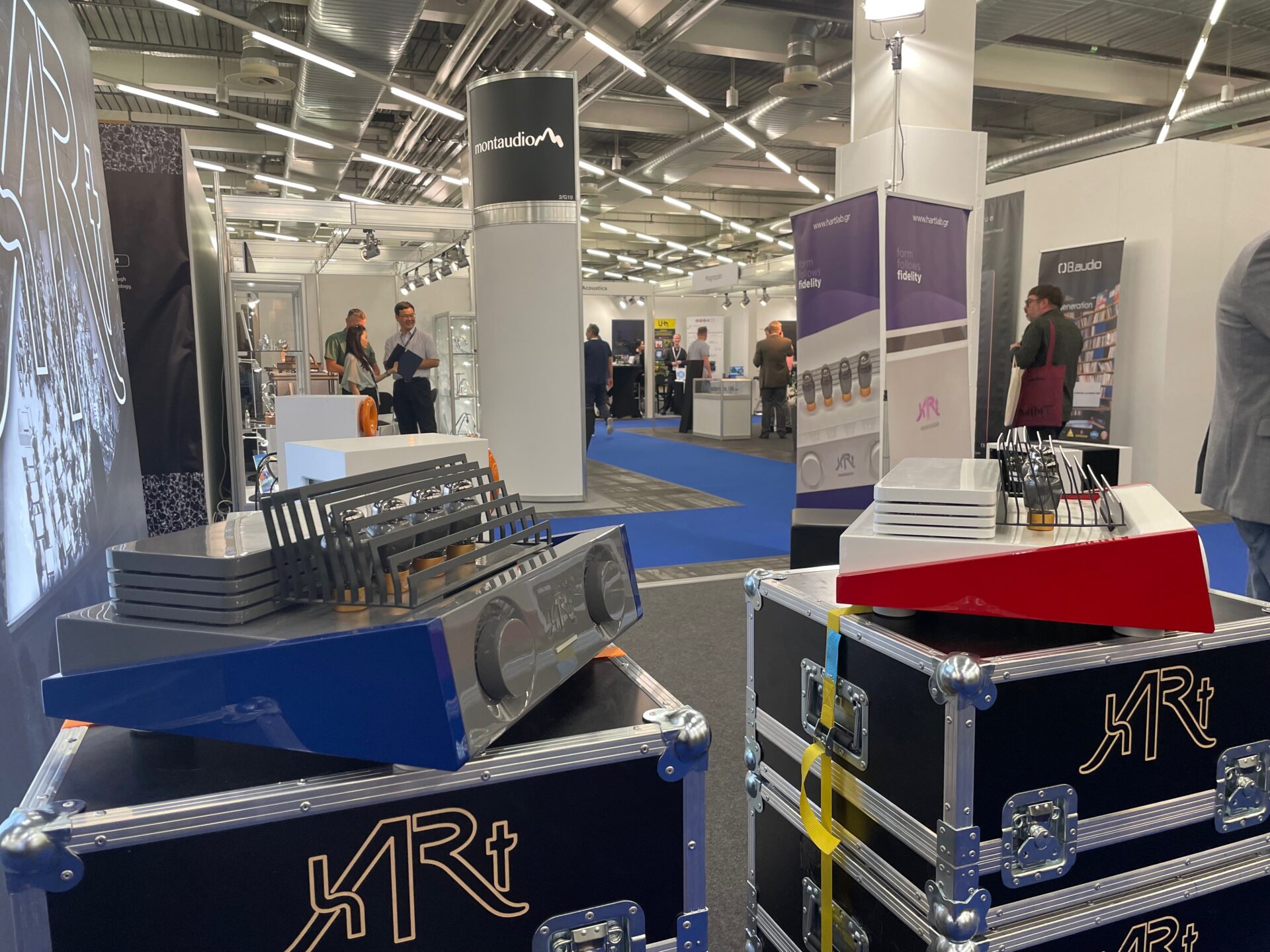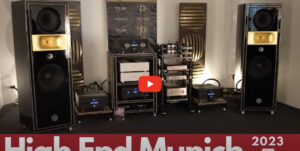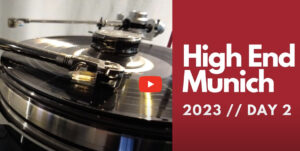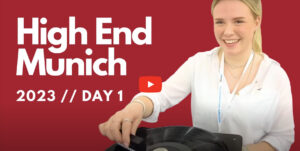The 2023 Munich High-End Show: Andrew Quint on Electronics and Digital
- SHOW
- by Andrew Quint
- Jun 03rd, 2023

It’s traditional for a first-time attendee of the Munich show to note his or her impressions of the experience, and who am I to defy tradition? This is high-end audio’s biggest stage, and few manufacturers with claims to (or aspirations for) an international presence will miss the chance to make a splash, as their stature and resources allow. Wilson Audio loudspeakers could be heard in no fewer than nine rooms; hARt Labs, a relatively new Greek company producing distinctively styled electronic components, bravely held forth at a corner booth display amidst the cacophony of Hall 2. As you’ve heard, the extent of what there is to hear and see is vast, but the show is exceptionally well run. The Internet works consistently, signage is excellent, and, for once, elevators aren’t a consideration unless one’s mobility is: The show is contained on three floors and two sets of broad, well-travelled stairways get you from one realm to another.

Is the quality of sound reproduction at the Munich show inferior to that experienced in Rockville, Tampa, or Schaumburg, as is often repeated? Certainly not, if the comparison is with a small hotel room. But maybe it really doesn’t matter all that much because, above all else, the yearly Munich event is about commerce. Plenty of gear is on “static display,” with gleaming prototypes, dramatically lit, silently wait for their turn at next year’s show. Pricing hasn’t necessarily been finalized. Especially during the two trade-only days, company reps meet with dealers and distributors at a small table in the manufacturer’s room to discuss specifics, music playing a few yards away. Additionally, there are rows of small, soundproof spaces designed for private transactional encounters.
Still, High-End Munich is the ultimate place to hear new products, and I’ll do my best to report on as many as possible from my assigned categories. Another standard trope from Munich show reports is the heartfelt apology for products overlooked in the florid abundance of audio gear that is this event. I’m past that. At High-End Munich 2023, I encountered more than enough terrific new stuff to know beyond any doubt that the health of this industry is robust. Maya Angelou may have said it best: “Forgive yourself—no one else will.”
So, here are 45 or so new products that got my oft-divided attention at High-End Munich 2023.

At a Thursday morning press conference, Naim introduced its 300 series components that include the NSS 333 streamer ($10,999), the NAC 332 preamplifier ($10,999) that borrows the much-admired volume control from the Naim Statement, the NAP 350 monoblock amplifiers ($8499) and the NVC TT phonostage ($3699), as well a couple of new external power supplies. Also proudly presented was a 50th Anniversary product, the NAIT 50 ($3699), a 25Wpc integrated with retro styling, a phonostage, no remote, and what Sales Manager Jason Gould referred to as “a good old-fashioned toroidal transformer.” The product will be made in a limited edition of—you guessed it—1973 units.
NAD launched its C 3050 stereo amplifier ($1399), another nod to the 1970s, at least in terms of the look of the component—a rectangular box with a faux wood top and a busy front panel with a couple of VU meters that are probably unnecessary. Inside, however, the C 3050 is an up-to-date piece of electronic gear with BluOS streaming, Dirac Live room correction, and NADs unique HybridDigital UcD amplification circuit. JBL presented its Classic series, which includes both electronics and loudspeakers. The system looks like it’s traveled from 1973 (love those orange grille covers) but, as with the Naim and NAD gear, the sound is very much 2023. The JBL system was getting some impressively controlled bass production—not what I remember from 1973, when I can remember anything at all.
At a morning press conference on the first day of the show, the French manufacturer Métronome introduced the AQWO 2 (€19,000), which replaces the good-selling AQWO that’s been around since 2018. In a larger chassis with a higher resolution touchscreen, it adds streaming capability to the earlier product—Tidal, Qobuz, Spotify, Deezer, and Internet radio via vTuner are “embedded”—as well as PCM decoding up to 384kHz and DSD up to 512. Fans of the earlier model will be happy to know that discs still load on top. Another French company, B. audio played its new Alpha One streaming integrated amplifier (preorder price, €15,990.) Expensive, for sure, but this small box does it all, and it’s obvious no corners have been cut. The DAC is of the Sigma/Delta type, and B.audio’s patented SRJ clock management process is said to reduce jitter to exceptionally low levels.

Another presser was held by AVM across the street from the M.O.C. at the Drivers & Business Club Munich. The German company spent much of the pandemic tripling production capacity at its Malsch factory and has a bunch of new products to show for it, including the CS 30.3 all-in-one media player (€3990, €4790 with chrome faceplate). The company also demonstrated its first-ever loudspeaker, the aluminum-clad Audition CB 2.3 (€2990), something I’m mentioning as I didn’t spot RH among the motorcycles and sports cars.
T+A was playing its R 2500 R multisource receiver, an all-in-one component (streamer, disc drive, DAC, broadcast/Internet radio, 250 watts of amplification) that’s at once a “lifestyle” product—the single box will be popular with the non-audiophile member of a domestic dyad—and the potential hub of a no-compromise music system. For example: Like T+A’s stand-alone DACs, there are separate paths for the PCM and DSD processors—a double differential quadruple converter with four 32-bit D/A converters per channel up to 768kbps, and T+A’s True 1-bit converter up to DSD 512.
The production version of the Dan D’Agostino Relentless 800 Mono amplifier ($194,500/pair) was introduced at High-End Munich 2023. It’s promoted as a “smaller platform” than the Epic 1600, and I suppose it is but…well, don’t expect to bring one home under your arm. 800 watts into 8 ohms, 1600 in 4. Hopefully, you don’t need more than that.
At €21,800, the Gryphon Audio Designs Diablo 333 is a bit more powerful than the model it replaces, the Diablo 300. Some technologies from the current Gryphon flagship amp, the Apex, have made it into the 333—newer, superior parts (“ultra-fast, low-capacitance pre-driver transistors”) are said to improve both “musicality and…measured performance.” With Gryphon EOS 2 loudspeakers, both dynamic impact and subtle orchestral detail were excellent on István Kértesz’s 1960s recording of the “New World” Symphony—the exhibitor’s choice, not mine. A wonderful performance, but not one I usually think of as “demonstration material,” so that’s something. Pretty reasonable price for a top echelon amplifier, too.
Trilogy Audio Systems—founder Nic Poulson remains the principal designer—showed off the new hybrid 994 monoblock (€12,000) that occupies the middle position in the manufacturer’s range of power amplifiers, between the 993 stereo and the 995R monos. Like the other two, the 994 employs a 6H6 “supertube” in the signal path before a compound output stage. There’s no negative feedback, and the rated power is 140 watts into 8 ohms, 200 watts into 4. That’s in Class AB mode; the 994 can also run in Class A up to 20Wpc into 8 ohms.
Soulution has a new offering in its 7 series, the 727 linestage (€55,000.) The manufacturer emphasizes that the new preamplifier is no mere “upgrade” but an entirely new design that’s resulted in a reduction to the noise floor of 20dB and higher common mode rejection. In service with Soulution amplification and big Clarisys ribbons, the sound was commanding, though not at the cost of nuance and detail.

Audio Group Denmark, well known to elite audiophiles for Børresen (loudspeakers), Aavik (electronics), and Ansuz (cables) debuted a completely new brand, Axxess, promoted as “available at a more modest price.” The initial offering is three streaming amplifiers, the Forté 1 (€5000), Forté 2 (€7500), and Forté 3 (€10,000), which vary in the number of active Tesla coils (the low-noise, current/voltage-producing elements in Aavik electronics for over a decade) and dither circuits, among other things.
Chord Electronics showed its new integrated amplifier, the ULTIMA, a 125Wpc stereo piece that nested comfortably beneath that manufacturer’s elegant Classic DAC. Electrical shielding has been painstakingly applied to reduce RFI to a minimum and, played through Bowers & Wilkins floorstanders, there was a gratifying ease to the presentation.
Musical Fidelity resurrected the Nuvistor tube for its Nu-Vista electronics range more than 15 years ago and in Munich introduced the Nu-Vista 800.2 integrated amplifier ($9900). There are five pairs of high-current power transistors per channel and the 800.2 delivers 330Wpc into an 8-ohm load, 560Wpc into 4, and a whopping 1000Wpc (peaks) into 2 ohms—the amp should drive just about anything without breaking a sweat. Plenty of line-level inputs and outputs are provided, and the copper binding posts are quite substantial, facilitating bi-wiring.
For a small country, Greece has a remarkably vital audio community—manufacturers, distributors, magazines and, of course, enthusiasts. HARt Lab (the logo is next to impossible to read—I wandered Hall 2 for ten minutes before finally locating its booth) builds five products—two preamps (Tune Two and Tune Four, 25,000€ and 31,000€, respectively) a pair of big monoblocks (Tune Five, 64,000€), a dual mono two-channel amplifier (Tune Three, 30,000€), and an integrated amplifier (Tune One). There’s a phonostage, DAC, streamer, and headphone output in both preamplifier models and in the integrated, a web-based remote control (as well as a physical one), and removable side panels with several choices of high-gloss automotive finish including B&W blue, Ferrari red, and Lotus yellow.

Two new assault-on-the-art headphone amplifiers were well received. The Yamaha HA-L7A headphone amplifier (price approximately $5k), which has been teasing enthusiasts in prototype form for some time, could actually be heard at this year’s Munich show. The DAC section is based on the ESS 9038Pro chip that will handle PCM to 32-bit/384kHz and DSD up to 11.2MHz. The brilliant Brits from dCS were featuring their lower-priced Lina line, introduced in 2022, which includes a Network DAC, a master clock, and a headphone amplifier ($9750.) The output stage is Class AB, allowing both linearity and efficiency. The sound is neutral, and the small form factor case doesn’t get especially hot.

SPL is a German company that has produced electronics for recording professionals for decades and has more recently moved into the high-end consumer market. Unique to SPL components is what the manufacturer refers to as VOLTAiR, or “120V technology”—the operating voltage inside of the audio device is four times that of a typical IC-based op-amp. This is said to greatly increase dynamic range and maximum output levels, and to improve signal-to-noise ratio. A new product introduced in Munich was the Diamond D/A Converter (€2499), which can accommodate six digital sources and features an external word clock and analog volume control.
HiFi Rose, headquartered in Seoul, South Korea, added to an already comprehensive lineup of sophisticated electronics—a CD drive and a couple of media players as well as several streamers and a beautiful integrated amplifier. The RS130 Ultimate Network Transport (price TBD) is intended to connect digitally to an external DAC. There’s fiber-optic connectivity via both Ethernet and USB; other noteworthy features include a high-precision OCXO clock and network streaming from an SSD cache. HiFi Rose is distributed in the U.S. by MoFi in Chicago.
The Italian electronics manufacturer, Ångstrom Audiolab was eager to show off (silently) its lower-priced Zenith Series electronics, in which the ZIA100 integrated amp ($10,000) is the most recent to reach market. A look inside was offered: The Zenith products have printed circuit board with meticulously rounded traces, as opposed to the discrete point-to-point wiring of the pricier Stella models. The company is planning a more visible U.S. presence in the near future.

Eastern Europe, especially the countries once under the control of the USSR, are playing an ever-increasing role in the high-end ecosystem—and it’s not just Estelon. A Hungarian company I was previously unacquainted with (though they do have an American distributor, Mark Sossa of Well-Pleased AV in Virginia) is Audio Hungary, which has been building tube preamplifiers and power amps for a decade. Brand new is the Qualiton A35, a 35Wpc Class AB design that features a transformer made in-house and a proprietary bias control. The price is around $5000. Also from that corner of the world, I made the acquaintance of Ferrum Audio, from Pruscków, Poland. Ferrum is Polish for iron and the company’s small rust-colored cases are quite attractive. Premiering at Munich was the Wandla DAC/Preamp ($2795), which uses the ESS Sabre ES9038PRO DAC chip and offers PCM resolution up to 768k/32-bit and DSD 256. Weighing in at just under four pounds, this compact device accepts a wide range of digital inputs.
Moon by Simaudio recently introduced its North Collection—six new components at three different price/performance tiers. At the entry level are the 681 streamer/DAC ($12,000) and 641 integrated amplifier ($11,000); in the middle, the 791 streaming preamp ($16,000) and 761 power amplifier ($14,000); and, for the most ambitious end of the range, the 891 streaming preamp ($25,000) and 861 power amp ($25,000.)
Edgar Choueiri, the scientist behind Theoretica Applied Physics, was tirelessly demonstrating the new MkIII version of the BACCH-SP adio stereo purifier ($26,000 base price), the most advanced crosstalk-cancellation device yet developed; it was our Technology Breakthrough Product of the Year for 2022. Choueiri reported that, with the latest example of JansZen Audio Valentina A8 loudspeakers ($12,750), he was achieving 16dB of crosstalk cancellation (XTC) in his M.O.C. room. This latest iteration of the product, which employs the tenth version of the XTC filter, features a more powerful CPU that allows for more accurate head tracking. Owners of earlier BACCH-SPs can upgrade to current status for between $2000 and $3500, depending on the model and vintage.
Ideon Audio, whose top-of-the-line Absolute Epsilon digital products graced the cover of TAS Issue 327 last year, has a new trio of less expensive components—the eos DAC (9700€), the eos Time reclocker (6000€), and the eos Stream (a streamer, of course, 9900€). All three together cost about half of what the Absolute DAC alone goes for. Yet, many design principles have trickled down to the new products from above. I wish I could have heard them; surely the opportunity will come up before long.
The Nagra Classic DAC II ($18,500) employs the same digital engine as the company’s flagship HD DAC X. The discrete Class A FET output stage produces a signal characterized by second-order harmonics, the intent being to emulate the sound of tube gear. High-resolution formats sounded great, but Nagra is justifiably proud of the DAC II’s performance with 16/44 Red Book. An external power supply is an option.

There were new streamers from two manufacturers that specialize in that product category. Bluesound introduced the NODE X Premiere Wireless Multi-Room Streamer, ten years after the release of the original NODE. The DAC chip is the well-regarded ESS Sabre ESS9028Q2N, and a lot of attention has been given to the headphone amplifier. A whole-house system is readily configured. The price? $749. Lumin was demonstrating its new U2 Network Music Transport ($5000)—in modern digital lingo, a “transport” is a streamer plus a renderer. It featured an all-new, higher-resolution processor that decodes PCM up to 768k and DSD 512 and will upsample DSD 256.
The Czech company Audiopraise, in business since 2004, is usually out of the spotlight, devising digital circuits for others: Several years ago, I reviewed a replacement board for Oppo players that did indeed improve the performance of Everyone’s Favorite Disc Player. Audiopraise has since started selling electronics with its own name on them, including the Avarice dejittering and upsampling unit and the VanityPro multichannel HDMI Audio Extractor ($1599). Brand new was the AP Link, a transmitter/receiver that can transmit 32 channels of digital data over an Ethernet cable of significant length.
Andrew Quint’s Best of Show
Best Sound (for the money)
Neither the YG loudspeakers nor the Burmester electronics behind them in the audio chain are inexpensive, but given the prevalence of six-figure products in both product categories, everything I heard in YG’s room struck me as the kind of value proposition a real-world audiophile could invest in. I visited YG’s exhibit three times and heard four loudspeakers—Tor ($10,500) and Ascent ($19,000) from the entry-level Peaks product range, the Vantage 3 Live (a powered speaker, $65,000), and the new Hailey 3 ($63,400). With all kinds of music, the sound was spacious and realistically detailed, musically engaging even at the very end of four long audio days.
Best Sound (cost-no-object)
The Tidal for Bugatti project—owners of a Bugatti automobile, and others, can purchase a bespoke loudspeaker that not only picks up design elements of the iconic roadsters but also speaks more generally to the concept of ultra-high-end design and industrial execution. What we heard was astounding: holographic imaging, instantaneous transients, and a completely neutral rendering of color and texture. I can’t afford either the car or the speaker, but I’m glad I’ve been able to experience at least one of them.
Best Demo
You don’t expect an A/B comparison at a show this busy, but it was a little slow in the Trilogy/Wilson Benesch/Computer Audio Design room and CAD’s Scott Berry was happy to accommodate me. Berry had a new product, the USB Control ($750) which gets inserted into a component’s firmware update port. With the device in place, an already excellent-sounding system was clearly improved—less closed in, with a more extended top end and greater harmonic richness. Berry feels that the unpleasant aspects of digital sound are due to high-frequency noise, which his doodad addresses. I can only say it works.
Most Notable Trend
Retro styling of components, specifically 1970s aesthetics, seems to be all the rage, allowing manufacturers like JBL, NAD, and Naim to celebrate their longevity in a continually evolving market. Go for it! Fire up one or more of these products and throw on a copy of Boston’s first album. No one has to know that you’re actually streaming.
Tags: DIGITAL ELECTRONICS MUNICH SHOW REPORT

By Andrew Quint
More articles from this editorRead Next From Show
See all
The 2023 Munich High-End Show: Robert Harley Reports from the World’s Premier Audio Event
After two years of COVID shutdowns and last year’s meager […]
- by Robert Harley
- Jun 03rd, 2023

High End Munich 2023 Day 3 | Fremer’s Show Coverage
Saturday was the first of two consumer days at High […]
- by Michael Fremer
- Jun 02nd, 2023

Michael Fremer’s Day 2! | High End Munich 2023
Walk the halls, corridors and sound rooms of High End […]
- by Michael Fremer
- May 25th, 2023

Michael Fremer’s Day 1 Analog Show Coverage | Munich 2023
From Fremer: Day one started with a 7 AM breakfast […]
- by Michael Fremer
- May 23rd, 2023


















